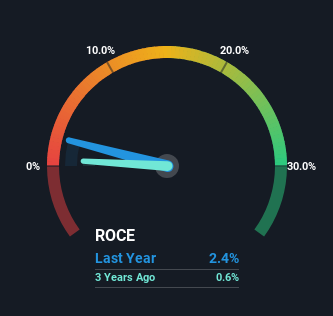- Hong Kong
- /
- Retail Distributors
- /
- SEHK:693
Some Investors May Be Worried About Tan Chong International's (HKG:693) Returns On Capital

What financial metrics can indicate to us that a company is maturing or even in decline? More often than not, we'll see a declining return on capital employed (ROCE) and a declining amount of capital employed. Ultimately this means that the company is earning less per dollar invested and on top of that, it's shrinking its base of capital employed. In light of that, from a first glance at Tan Chong International (HKG:693), we've spotted some signs that it could be struggling, so let's investigate.
Return On Capital Employed (ROCE): What Is It?
Just to clarify if you're unsure, ROCE is a metric for evaluating how much pre-tax income (in percentage terms) a company earns on the capital invested in its business. To calculate this metric for Tan Chong International, this is the formula:
Return on Capital Employed = Earnings Before Interest and Tax (EBIT) ÷ (Total Assets - Current Liabilities)
0.024 = HK$367m ÷ (HK$23b - HK$7.7b) (Based on the trailing twelve months to June 2023).
Thus, Tan Chong International has an ROCE of 2.4%. In absolute terms, that's a low return and it also under-performs the Retail Distributors industry average of 5.3%.
View our latest analysis for Tan Chong International

Historical performance is a great place to start when researching a stock so above you can see the gauge for Tan Chong International's ROCE against it's prior returns. If you'd like to look at how Tan Chong International has performed in the past in other metrics, you can view this free graph of past earnings, revenue and cash flow.
What Does the ROCE Trend For Tan Chong International Tell Us?
There is reason to be cautious about Tan Chong International, given the returns are trending downwards. To be more specific, the ROCE was 5.2% five years ago, but since then it has dropped noticeably. Meanwhile, capital employed in the business has stayed roughly the flat over the period. Since returns are falling and the business has the same amount of assets employed, this can suggest it's a mature business that hasn't had much growth in the last five years. So because these trends aren't typically conducive to creating a multi-bagger, we wouldn't hold our breath on Tan Chong International becoming one if things continue as they have.
Our Take On Tan Chong International's ROCE
All in all, the lower returns from the same amount of capital employed aren't exactly signs of a compounding machine. Investors haven't taken kindly to these developments, since the stock has declined 27% from where it was five years ago. Unless there is a shift to a more positive trajectory in these metrics, we would look elsewhere.
One more thing: We've identified 4 warning signs with Tan Chong International (at least 2 which can't be ignored) , and understanding them would certainly be useful.
While Tan Chong International isn't earning the highest return, check out this free list of companies that are earning high returns on equity with solid balance sheets.
Valuation is complex, but we're here to simplify it.
Discover if Tan Chong International might be undervalued or overvalued with our detailed analysis, featuring fair value estimates, potential risks, dividends, insider trades, and its financial condition.
Access Free AnalysisHave feedback on this article? Concerned about the content? Get in touch with us directly. Alternatively, email editorial-team (at) simplywallst.com.
This article by Simply Wall St is general in nature. We provide commentary based on historical data and analyst forecasts only using an unbiased methodology and our articles are not intended to be financial advice. It does not constitute a recommendation to buy or sell any stock, and does not take account of your objectives, or your financial situation. We aim to bring you long-term focused analysis driven by fundamental data. Note that our analysis may not factor in the latest price-sensitive company announcements or qualitative material. Simply Wall St has no position in any stocks mentioned.
About SEHK:693
Tan Chong International
An investment holding company, provides vehicles and related spare parts in Singapore, Taiwan, the People’s Republic of China, Japan, Thailand, and internationally.
Solid track record with mediocre balance sheet.
Market Insights
Community Narratives


